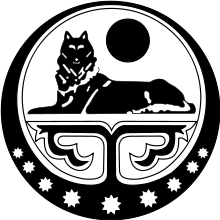- Chechen wolf
-
The wolf (Chechen: Borz, pronounced /bo̞ɾz/ or /bwoɾz/) is the national animal of the Chechen nation, and it is also the national embodiment.[1] The national feeling of Chechens towards the wolf has many aspects.
Contents
As a poetic or symbolic comparison to the Chechen nation
The Chechen people are symbolically said to be variously related to wolves (not in a serious way, but in an either symbolic or joking manner), probably in relation to the "Wolf Mother" legend. Hence, characteristics of the wolf are also frequently compared to the Chechen people in a poetic sense, including the most famous line that members of the Chechen nation are "free and equal like wolves". [2][3][4] Wolf clans are often equated to Chechen teips.
Chechen culture often emphasizes emulation of other characteristics of the wolf besides egalitarianism. As Jaimoukha explains in his ethnographic book on the Chechen people,
“ According to the Chechen ethos, the wolf is the onlyanimal that would enter into an unequal match, making up for any disadvantage by its agility, wit, courage and tenacity. If it loses the battle, it lies down facing the foe in full acceptance of its fate—Chechen poise equivalent to the famed British ‘stiff upper lip’.
” There is a saying in the Chechen language describing a person, "He/She was raised by the She-Wolf" which implies the person has admirable personality traits. [1]
Mythological
There is one myth that the mythological founder of the Chechen nation, Turpalo-Noxchuo (Chechen Hero, who Chechens are descended from "like sparks of steel"), was raised by a fabled, loving "Wolf Mother".
Old Chechen lore holds that the sheep was actually originally created for the wolf to enjoy, but man "stole" the sheep from the wolf (this is rather interesting considering that many Chechens in the past have in fact been shepherds). According to the ethnographic historian Jaimoukha, in olden times Chechens used to observe a wolf cult that would prevent lupine raids on sheep, by observing Saturday as being a special day. [1]
In insignia and symbols
The wolf is frequently used for insignia and images, as a symbol of the Chechen nation. Common poses involve the wolf howling off the top of a mountain (Chechnya is very mountainous), laying down, or staring at the viewer.
The different poses evoke different symbolism:
- The wolf howling off the top of the mountain is usually an expression of national pride. In the period of 1991-1994, broadcasts in independent Chechnya bore this symbol [5], in that case symbolizing the struggle for national recognition. The symbol is also used by Chechens nowadays as a simple expression of being proud they are Chechen.
- The wolf laying down, facing the viewer is usually a reference to the mythological "Wolf Mother" of Turpalo-Noxchuo.
- Staring at the viewer usually evokes a feeling of intense emotion that the artist is implying they believe is felt by the Chechen nation.
Modernly, the coat of arms of the secular separatists in Chechnya bore the wolf. The Islamists later removed it and replaced it with Arabic script, and the Russian-sponsored ruling regime removed it entirely, but the secular government in exile still uses it. In addition, many other insignia of the Chechen nation (of all three governments) use the wolf as a heraldic symbol.
In naming
- The gun manufactured by the Chechen separatists in the two Chechen wars was called the Borz, after the wolf. [6]
References
- ^ a b c d Jaimoukha, Amjad. The Chechens: A Handbook. Page 153.
- ^ Jaimoukha. Chechens. Page 83
- ^ Gammer, Moshe. The Lone Wolf and the Bear: Three Centuries of Chechen Defiance of Russian Rule. London 2006. Page 4
- ^ Wood, Tony. Chechnya: The Case for Independence. page 13.
- ^ Henze, Paul B; in collaboration with Tishkov, Valery. Islam in the North Caucasus: the Example of Chechenia. Originally completed September 1993, "somewhat updated", released May 1995. Available from website www.circassianworld.com in pdf form here: [1]
- ^ "Chechnya’s Homemade Weapons Fuel War". Iwpr.net. 2009-08-13. http://iwpr.net/?p=crs&s=f&o=161041&apc_state=henicrs2004. Retrieved 2009-10-22.
Heraldic creatures Beasts 
Birds Legendary
creaturesBasilisk · Biscione · Chollima · Cockatrice · Dragon · Enfield · Garuda · Griffin/Keythong · Harpy · Lindworm · Manticore · Phoenix · Salamander · Turul · Unicorn · WyvernFish Others Categories:- Heraldry
- Wolves
- Wolves in folklore, religion and mythology
- Chechnya
- Chechen culture
Wikimedia Foundation. 2010.

